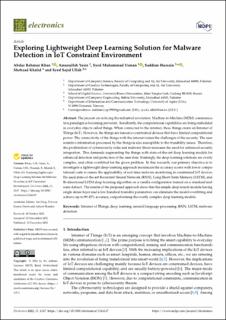Exploring Lightweight Deep Learning Solution for Malware Detection in IoT Constraint Environment
Khan, Abdur Rehman; Yasin, Amanullah; Usman, Syed Muhammad; Hussain, Saddam; Khalid, Shehzad; Sajid Ullah, Syed
Peer reviewed, Journal article
Published version
Permanent lenke
https://hdl.handle.net/11250/3068143Utgivelsesdato
2022Metadata
Vis full innførselSamlinger
Originalversjon
Khan, A. R., Yasin, A., Usman, S. M., Hussain, S., Khalid, S. & Sajid Ullah, S. (2022). Exploring Lightweight Deep Learning Solution for Malware Detection in IoT Constraint Environment. Electronics, 11(24), 1-17. doi: 10.3390/electronics11244147Sammendrag
: The present era is facing the industrial revolution. Machine-to-Machine (M2M) communication paradigm is becoming prevalent. Resultantly, the computational capabilities are being embedded
in everyday objects called things. When connected to the internet, these things create an Internet of
Things (IoT). However, the things are resource-constrained devices that have limited computational
power. The connectivity of the things with the internet raises the challenges of the security. The user
sensitive information processed by the things is also susceptible to the trusability issues. Therefore,
the proliferation of cybersecurity risks and malware threat increases the need for enhanced security
integration. This demands augmenting the things with state-of-the-art deep learning models for
enhanced detection and protection of the user data. Existingly, the deep learning solutions are overly
complex, and often overfitted for the given problem. In this research, our primary objective is to
investigate a lightweight deep-learning approach maximizes the accuracy scores with lower computational costs to ensure the applicability of real-time malware monitoring in constrained IoT devices.
We used state-of-the-art Recurrent Neural Network (RNN), Long Short-Term Memory (LSTM), and
Bi-directional LSTM deep learning algorithm on a vanilla configuration trained on a standard malware dataset. The results of the proposed approach show that the simple deep neural models having
single dense layer and a few hundred trainable parameters can eliminate the model overfitting and
achieve up to 99.45% accuracy, outperforming the overly complex deep learning models.

